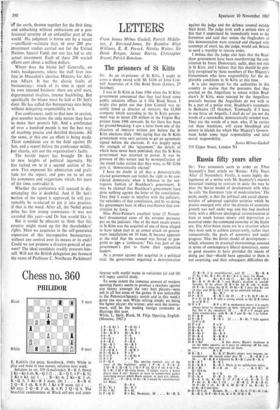Chess no. 360
PHILIDOR
Black
White 9 men
9 men E. Rukhlis (1st prize, Sverdlovsk, 1946). White to play and mate in two moves; solution next week. Solution to no. 359 (Loschinski): B ŌĆōR 5, threat 2 Kt ŌĆōKt.6 ch, KŌĆō Q 3 (2 ... K ŌĆō Q 5; 3 P ŌĆō K 3); 3 Kt X Kt. (a) 1 . . . B ŌĆōKt 4; 2 KtŌĆō K 3 ch, KŌĆōQ 3; 3 Kt ŌĆōB 5 mate. (b) 1 . . . B ŌĆōB 4; 2 QŌĆōR 3 ch, K X P; 3 Kt X P mate. (c) 1 . . . Kt any; 2 QŌĆōR 3 eh, K X P; 3 QŌĆō Q 6. The beautiful combination of Black self-pin and inter-
ference with model mates in variations (a) and (b) will repay careful study.
To some extent the immense amount of modern opening theory seems to produce a reaction against any theory amongst the very best playersŌĆöseen not in all but some of the games. It was noticeable in the Petrosian/Spassky match and in this week's game too one sees White relying simply on being the better player: the winner, who won the tourna- ment, will be the leading foreign contender at Hastings this year.
White, L. Stein. Black, M. Filip. Opening, English. (Moscow, 1967.)
1 P-K Kt 3 P-K Kt 3 2 B -Kt 2 B -Kt 2 3 Kt -K B 3 Kt -K B 3 40-0 0 -0 5 P - Q 3 P - Q 3 6 P-B 4 P -B 4 7 Kt - B 3 Kt -B 3 SR-Kit R -Kt 1 9 P -Q R 3 P - Q R 3 10P-QKt4 PXP 11 P X P P - Q Kt 4 12 P X P PXP 13 P - Q 4 ŌĆö . The opening reminds one of the story of the beginners' game 1 P - K 4, P - K 4; 2Q-R 5,Q-R 5; 3 QxPch,QXPch;4Qx1C, Q X K; 5 Q x QŌĆölong pause. 'I resign; you're a better player than I am. Sooner or later in symmetrical games something occurs which Black cannot, or dare not, imitate. Now 13 ... P - Q 4; 14 Kt -K 5 would be unsatisfactory for Black.
13 . . . B -B 4 14 R - Kt 3 Kt -K 5 15 Kt x Kt B X Kt
16 P - Q 51 B X Kt, Necessary. 16 . . . Kt - R 2; 17 B - K 3 is unsatisfactori, and 16 . . . Kt - K 4; 17 Kt x Kt, B x Kt; 18 Kt - B 6 is fatal, for Black.
17 P x B Kt - K 4. Or 17 ... Kt - Q 5; 18 R Q 3, Kt -B 4; 19 B - R 3 and Black's position is uncom- fortable. If he allows 20 B x Kt his K side is weak: 19 P - K 3 loses the Q P. 19 Kt - R 3 puts the Kt out of play and 19 Q - Q 2 sets up an awkward self-pin.
18 P -B 4 Kt - B 5 19 P -B 5! R - R 1. Or 19 . P x P; 20 P - Kt 41, P X P; 21 Q X P with a strong attack as the Q R comes in at KR 3, 20 PxP R P x P? A mechanical move; it is nearly always better to recapture, as here, 'towards the centre'ŌĆö but this is the exception. 20 ...BPxP would give more counter-play, with R - R 7 and Q - Kt 3 to follow.
21 P - R 4! R - R8 22 P - R 5 B - B 3 22 . . . B - Kt 7 fails against 23 P X P.
23 P X P P x P
24 Q - Kt 4 K - Kt 2 25 B -K 4 Q - K 1 26 B - Kt 1! Kt - K 4 27 Q - K 4 R-K R I 28 B - Kt 2 R - R 1 29 B X Kr! . . . A fine move; Black's weakness is on the white squares, so it pays to exchange off his only minor piece that can operate on them. BXB
30 R - 1 R - R 8? Black's pieces now become un- coordinated. He should either play 30 . . R - Q R 2 or 30. . . R - K R 4 followed by B -B 3 and R - K 4.
31 R - B 7 B - B 3 32 R - K B 3 R - R 3. There is no satisfactory move.
33 R x B! RXB ch 33 .. . KxR?; 34 Q-Q4ch.
34 QxR K X R
35 Q - K 4 - 11 2. Or 35 . . R-R 2; 36 Q-K 6 ch, K-Kt 4; 37 P-B 4 eh, K-R 3; 38 P -Kt 41, R. - Kt 2 (38 . . . R -B 2; 39 R - B 8): 39 P-Kt 5 ch. K-R 2; 40 Q-R 3 di, K-Kt 1; 41 R -B 8 and wins.
36 Q - Q 4 ch Resigns. 36 ... K -Kt 4; 37 Q -K 3 ch. K -R 5; 38 P - Kt 4 ch. K X P; 390 X R.






































 Previous page
Previous page